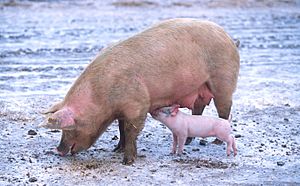Swine influenza facts for kids

Swine influenza virus is a type of virus that is common in pigs. This flu virus can also infect humans and birds. Swine influenza virus is often called SIV or swine flu.
Swine flu is common in pigs. Usually, it only infects people who have been very close to pigs. However, the disease has also spread from one person to another. Swine flu can cause a fever, make you feel confused, cause stiff joints, vomiting, and make you feel very tired. Sometimes, it can be very serious.
There are different types, or strains, of swine flu. They are called H1N1, H1N2, H3N1, H3N2, and H2N3.
Contents
What is Swine Flu?
The H1N1 strain of swine flu came from the Spanish flu. This flu caused a huge worldwide outbreak, called a pandemic, in humans in 1918 and 1919. New viruses came from the Spanish flu and became common in pigs.
Sometimes, these viruses spread from pigs to humans. This has happened many times over the years. It is hard to stop the flu virus because it changes all the time. When a person gets the flu, their body makes special fighters called antibodies. These antibodies help fight off that specific virus if it comes back. But because the flu virus keeps changing, the antibodies might not recognize the new version of the virus. This is also why flu vaccines need to be updated often.
How Flu Viruses Change
Small changes in the flu virus happen every two to three years. After about ten years, most people have developed antibodies to fight these small changes. But if the virus suddenly changes a lot, it can cause a pandemic. This means hundreds of millions of people might find their antibodies are not useful anymore. Even during the Spanish flu pandemic, the first wave of the disease was not very serious, but the second wave was extremely deadly.
In 1957, a flu pandemic called Asian flu infected about 45 million Americans and caused 70,000 deaths. Eleven years later, from 1968 to 1969, the Hong Kong flu pandemic infected 50 million Americans and caused 33,000 deaths. In 1976, about 500 soldiers got swine flu over a few weeks. However, the virus then "mysteriously disappeared." There were only a few other cases around the U.S. in people who were thought to have caught the virus from pigs.
Scientists worry that the swine flu virus might mutate, or change, into a pandemic as serious as the 1918 one. They watched the outbreak in 2009 closely and made plans for what to do if a global pandemic happened.
Symptoms of Swine Flu
The main symptoms of swine flu are much like those of regular influenza. These symptoms can include:
- Vomiting
- Nausea
- Runny nose
- Loss of appetite
- Lethargy (feeling very tired)
- Chills
- Fever
- Body aches
- Sore throat
- Coughing
- Diarrhea
- Stomach ache
Where Swine Flu is Found
The bird flu virus H3N2 is common in pigs in China. It has also been found in pigs in Vietnam. Experts believe this could lead to new types of the flu virus. Pigs can carry human flu viruses. These viruses can mix in new ways and share some of their genes with H5N1, another type of bird flu. Through mutation, this could create a virus that spreads easily among humans.
In August 2004, researchers in China found H5N1 in pigs. In 2005, it was found that H5N1 might be infecting up to half of the pig population in some parts of Indonesia. These pigs did not show any symptoms. Scientists tested the blood of healthy pigs near chicken farms where bird flu had broken out. Five of the pig samples had the H5N1 virus.
Swine Flu in Humans

The Centers for Disease Control and Prevention (CDC), a U.S. government agency, says that swine flu symptoms and how it spreads from person to person are much like regular seasonal flu. Common symptoms are fever, lethargy (feeling tired), lack of appetite, and coughing. Some people with swine flu also have a runny nose, sore throat, nausea, vomiting, and diarrhoea.
It is believed to spread between humans when an infected person coughs or sneezes. The virus can land on surfaces. Another person might touch that surface and then touch their own nose or mouth. Swine flu in humans is most contagious during the first five days of being sick. Some people, especially children, can be contagious for up to ten days. Doctors can diagnose it by sending a specimen (a sample) to a lab for testing within the first five days.
There are four medicines approved in the United States to treat swine flu: amantadine, rimantadine, oseltamivir (Tamiflu), and zanamivir (Relenza). For the 2009 outbreak, oseltamivir and zanamivir were recommended. The vaccine for the human seasonal flu does not protect against swine flu.
Swine Flu Vaccines for Animals
The swine influenza virus has evolved a lot in recent years. This has made swine flu a bigger problem because regular vaccines against flu do not always work against it. There are special vaccines for swine flu, but they only work if the virus strain is similar enough to the vaccine. For more difficult cases, very specific vaccines are made to match the exact virus strain.
Current vaccines for SIV in pig farms usually use one of several common SIV vaccines. However, many H3N2 virus types found recently did not react strongly to these vaccines. This means that the current vaccines might not fully protect pigs from many H3N2 viruses.
The vaccine for the human seasonal flu strain H1N1 is not expected to protect against swine flu. The director of CDC's National Center for Immunization and Respiratory Diseases said that the 2009 swine flu cases had parts from four different flu viruses. These included North American swine flu, North American bird flu, human influenza A virus subtype H1N1, and swine flu viruses from Asia and Europe. The virus was found to be resistant to amantadine and rimantadine, but could be treated with oseltamivir (Tamiflu) and zanamivir (Relenza).
The 2009 Outbreak
A new type of swine influenza A called H1N1 caused the swine flu outbreak in humans in 2009. This virus was a mix of several flu strains from humans, birds, and pigs. Tests showed that parts of the virus were similar to swine flu viruses found in U.S. pigs since 1999. However, other parts of the virus were like versions found in European pigs. Viruses like this had not been seen in humans or pigs before.
Other Pages
- Bird flu
- Pandemic
- List of epidemics
- Infectious disease
See also
 In Spanish: Gripe porcina para niños
In Spanish: Gripe porcina para niños



